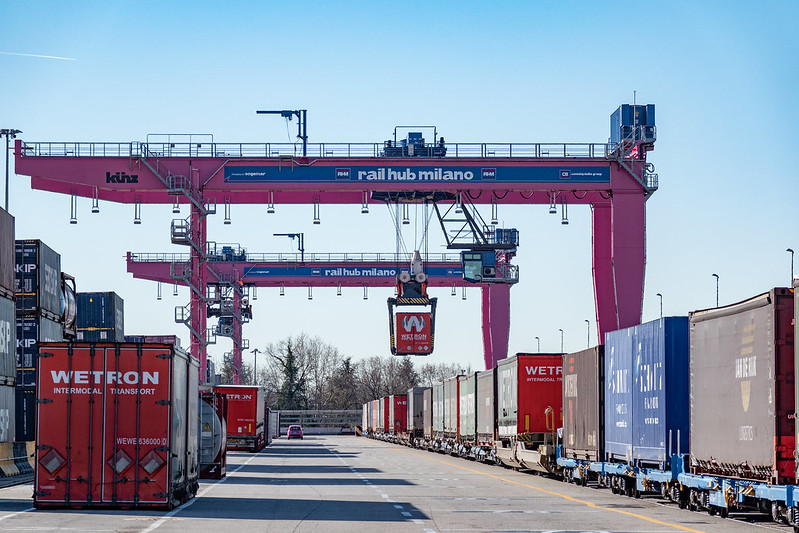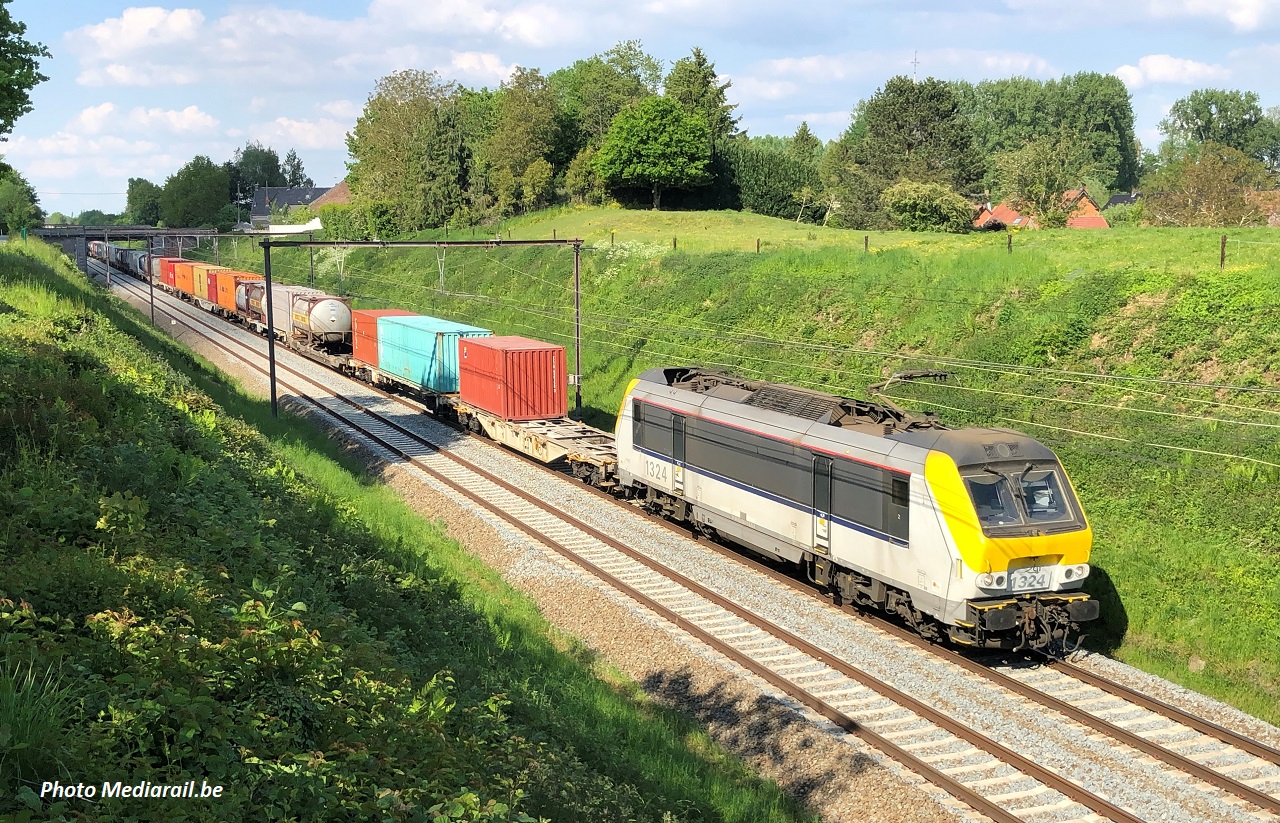(picture above: short line in Sweden, by smiley-toerist via wikipedia)
By Frédéric de Kemmeter – Railway signalling and freelance copywriter – Suscribe my blog
16/01/2022 – (Version en français)
🟧 Back to homepage 🟧 See our brief news
While the share of rail in land freight transport was still 33 percent in 2010, it fell to 28 percent by 2020. According to the Austrian Transport Club (VCÖ), the decline of factory sidings to the public rail network is partly to blame and needs to be reconsidered.
The private connection of a factory to the main network is something that has existed since the invention of the railway. All the coal mines were connected to the railways, and it was these mines that were responsible for the construction of the many railway lines in England, Wallonia, northern France and the Ruhr. Subsequently, all industry and, for example, quarries were connected to the rail network, as rail was the dominant form of transport at the time.
The evolution of roads, first with cobblestones and then with bitumen from the 1950s onwards, completely changed these parameters. Firstly, many coal mines ceased to exist, leaving miles of railway line useless. But then, the flexibility of the road mode largely outweighed the advantages of rail, at a time when ecological concern was zero…

Today, some companies still have private rail connections, notably in the chemical, automotive and steel industries and some large warehouses. Some European ports also have an important internal rail network (Antwerp, Rotterdam, Hamburg).
But it is undeniable that for SMEs and smaller industries, the rail connection is no longer the solution. Filling 5 or 10 wagons per week is not environmentally friendly because it is always a heavy locomotive that has to pick them up, sometimes far from the main network, on small UIC lines classified 7 to 9 and which are in poor condition.
Siding railways are non-public railways and usually without scheduled services. Although they are not subject to an operating obligation, they are subject to a maintenance obligation. Unfortunately, the legislation still classifies these tracks as « heavy rail », with all the constraints that this implies.
In addition to this, there is the peculiar vision of logistics developers to look for land along the motorways rather than along the railway lines.
This view is largely encouraged by politicians and by pressure from voters who are « burnt out by the presence of trains in the middle of their beautiful countryside ». So a warehouse might as well be put where no one lives, i.e. along noisy roads.
This is how, since the 70s and 80s, almost all logistics sites have been built exclusively on the basis of road transport criteria. And this continues to this day…
Climate goals
This development in freight transport is contrary to the climate goals, because transport by rail is much less harmful to the environment than transport by road. Freight transport is responsible for 37 percent of greenhouse gas emissions from road transport. HGVs cause 99 percent of the CO2 emissions of land freight transport. Per tonne-kilometre, rail freight transport causes five grammes of direct and indirect greenhouse gas emissions, but truck transport causes many times that amount, with an average of 85 grammes.
Shifting freight transport from road to rail would therefore be an important contribution to an effective climate and environmental policy. In this context, the VCÖ draws attention to the connection between companies and the general railway network, namely the connecting railways: in Austria, two thirds of the transport volume on the railways is handled by connecting railway. While every company site receives a publicly financed road connection as standard, companies are left to bear a large part of the costs for connecting railways, criticises the transport association.
However, it is questionable whether companies nowadays really care about CO2 when their interests are at stake! Who would want to jeopardise their logistics flow by using bad rail services to save the planet? Because a company lives on sales, deadlines, reliability and flexibility. Can we decently ask Amazon to slow down its deliveries and use rail instead of polluting planes?

Decreasing in Austria
The number of active factory sidings is constantly decreasing in Austria, according to VCÖ. In 2020, there were 1,046 registered connecting railways, of which only half, 547, were operated. Compared to 2010, when 782 connecting railways were served, this represents a decline of 30 percent. In the same period, the share of rail freight transport in terms of net tonne-kilometres fell from 33 percent to 28 percent in 2020.
However, single wagon transports account for almost half of the modal share in Austria and are therefore critical for the success of rail’s market share. Compared to other European countries, the Austrian operator Rail Cargo Group has a very high service density with more than 400 handling points in Austria and 350 in Hungary. Around two million journeys are handled annually with single wagonload transports.
A survey among members of the Association for Connecting Railways shows that above all the lack of suitable wagons, too long transport times and too high costs are cited as reasons for discontinuing connecting railways. Another hurdle is the discontinuation of branch lines. The situation is aggravated by the fact that service runs for goods trains are often only maintained if the connecting railways have a minimum turnover.
Politics cannot fix everything
Switzerland has had some problems with subsidising factory private sidings. The Confederation supports the construction of sidings with financial aid, but under conditions of certain volumes transferred to rail, written down by contract. In the case of lower volumes, the factory must reimburse the Confederation for part of the aids. In 2019, the Federal Office of Transport found irregularities and non-reimbursements that had to be settled in court…
In Austria, a survey of the VCÖ members shows that the lack of suitable wagons, too long transport times and too high costs are the main reasons given for abandoning their railway siding. Another obstacle is the abolition of branch lines. The situation is made worse by the fact that goods train services are often only maintained if the feeder railways achieve a minimum turnover.
In contrast to the publicly financed road connection of company premises, there is a funding ceiling of 40 percent and a maximum of 2.5 million euros for new constructions, extensions and maintenance for connecting railways – in return for a transport obligation period and a minimum annual tonnage of transports.
This shows the great danger to make policies with assigned figures. With the current pandemic and the drop in activity, what are Swiss or Austrian contracts and their transfer volumes still worth?
The VCÖ calls for a turnaround in freight transport through more cost absorption, expert advice for companies and the creation of a competent contact point. Other associations and countries are making similar requests. However, rail operators must be able to find viable solutions in the wagonload policy. This sector suffers from having evolved very little over the last 100 years, and still today requires a lot of manoeuvres and manpower.
Political will is one thing. Industry’s desiderata are another. Can technology be a cure? That depends. So far, the autonomous wagon that runs without a locomotive exists only on paper. And the day it does exist, it will have to be allowed to run by the administration and politicians will have to give their approval by changing railway legislation. This is not a foregone conclusion…

16/01/2022 – By Frédéric de Kemmeter – Railway signalling and freelance copywriter
Suscribe my blog
Related topics:
 Interporto, a tool to create the conditions for modal shift
Interporto, a tool to create the conditions for modal shift
05/12/2021 – It is misleading to think that the mere construction of a railway infrastructure in a economic area can generate a process of economic growth. There are a need for more complete facilities and industries around them. This is what the Italian example shows us with his ‘Interpoto‘ concept.
 Rail to replace truckers?
Rail to replace truckers?
19/10/2021 – In recent times, problems with the lack of truck drivers have forced some logistics companies to turn to rail. Can railways resolve this problem? Not an obvious answer.xxxx xxxxxx xxxxxxxxxxxx xxxxxxx
 Doubling rail freight: a very ambitious goal
Doubling rail freight: a very ambitious goal
13/06/2021 – There is little debate around the importance to move freight from road to rail. This shift is a key strategy for contributing to the European Green Deal’s goal of decreasing freight’s CO2 emissions. Europe has set a goal to increase the sector’s market share to 30% by 2030.
 How rail is bringing fast service parcels back on track
How rail is bringing fast service parcels back on track
03/01/2021 – The parcels have long since deserted the trains. There is a reason for this. But it is sometimes said the postman is ringing always two time. There are today some example of the come-back of parcels in trains.
 How railways can be reconnected with logistics
How railways can be reconnected with logistics
11/09/2020 – How can rail increase its market share? By more focus on the logistics industry
 Is automatic coupling on freight wagon will become reality?
Is automatic coupling on freight wagon will become reality?
09/07/2020 – Europe is finally testing an automatic coupling for its freight trains. But now with digital attributes. This coupling will make it possible to operate « intelligent trains »
 British rail freight before Brexit
British rail freight before Brexit
01/06/2019 – Brexit is coming soon. It is therefore wise to give a final account of the state of rail freight in Britain before future events come to reconsider everything.


Vous devez être connecté pour poster un commentaire.